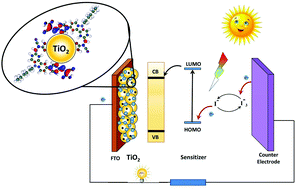当前位置:
X-MOL 学术
›
Photochem. Photobiol. Sci.
›
论文详情
Our official English website, www.x-mol.net, welcomes your
feedback! (Note: you will need to create a separate account there.)
New di-anchoring A–π-D–π-A configured organic chromophores for DSSC application: sensitization and co-sensitization studies†
Photochemical & Photobiological Sciences ( IF 2.7 ) Pub Date : 2018-01-03 00:00:00 , DOI: 10.1039/c7pp00351j Praveen Naik 1, 2, 3, 4, 5 , Rui Su 6, 7, 8, 9 , Mohamed R. Elmorsy 6, 7, 8, 9 , Ahmed El-Shafei 6, 7, 8, 9 , Airody Vasudeva Adhikari 1, 2, 3, 4, 5
Photochemical & Photobiological Sciences ( IF 2.7 ) Pub Date : 2018-01-03 00:00:00 , DOI: 10.1039/c7pp00351j Praveen Naik 1, 2, 3, 4, 5 , Rui Su 6, 7, 8, 9 , Mohamed R. Elmorsy 6, 7, 8, 9 , Ahmed El-Shafei 6, 7, 8, 9 , Airody Vasudeva Adhikari 1, 2, 3, 4, 5
Affiliation

|
Herein, we report the design and synthesis of three new un-symmetrical metal-free carbazole based organic dyes, E1–3 with A–π-D–π-A architecture, as effective di-anchoring sensitizers in DSSCs. The new entities comprise carbazole as a donor scaffold connected to three different units, viz. cyano acetic acid, 2,4-thiazolidinedione and barbituric acid as acceptor/anchoring units via vinylene and phenylene as π-spacers at 3- and 6-positions of the carbazole ring, respectively. Photophysical, electrochemical and theoretical studies were carried out in order to assess their feasibility as active sensitizers. Furthermore, their photoelectrochemical performances and charge transport properties in fabricated DSSCs were evaluated. The results revealed that the device fabricated with the E1 sensitizer displayed the highest PCE of 2.38% among the three dyes. Its JSC, VOC, and IPCE values were found to be 6.36 mA cm−2, 0.599 V, and 57%, respectively. Its enhanced performance is attributed to the presence of a highly electron withdrawing cyano acetic acid unit on either side of the carbazole core through appropriate π-spacers. Interestingly, the DFT study indicated that the electron cloud of the LUMO level has been shifted significantly towards the 2-cyano phenyl acrylic acid connected at the 6th position of the carbazole ring, when compared to the cyano acrylic acid linked at position 3, confirming efficient charge separation in E1. The assigned lifetimes of E1–3 obtained from EIS studies were found to be in accordance with experimentally obtained photovoltaic parameters. Furthermore, E1–3, when co-sensitized with NCSU-10 sensitizer in DSSCs, displayed higher VOC values, but lower PCE values than that of NCSU-10.
中文翻译:

用于DSSC的新型双锚定A–π-D–π-A配置的有机发色团:敏化和共敏化研究†
在此,我们报告了三种新型不对称无金属咔唑基有机染料E 1–3(具有A–π-D–π-A结构)的设计和合成,它们是DSSC中有效的双锚定敏化剂。新实体包括咔唑作为连接到三个不同的单元,一个供体的支架即。氰基乙酸,2,4-噻唑烷二酮和巴比妥酸通过受体/锚定单元亚乙烯基和亚苯基分别在咔唑环的3位和6位上作为π间隔基。为了评估它们作为活性敏化剂的可行性,进行了光物理,电化学和理论研究。此外,评估了它们在制备的DSSC中的光电化学性能和电荷传输性能。结果表明,用E 1敏化剂制成的器件在三种染料中显示出最高的PCE,为2.38%。发现其J SC,V OC和IPCE值为6.36 mA cm -2,0.599 V和57%。其增强的性能归因于咔唑核的任一侧通过适当的π-间隔基存在高度吸电子的氰基乙酸单元。有趣的是,DFT研究表明,与在3位连接的氰基丙烯酸相比,LUMO能级的电子云已显着移向咔唑环第6位连接的2-氰基苯基丙烯酸。E 1中的有效电荷分离。从EIS研究获得的E 1-3的指定寿命与实验获得的光伏参数一致。此外,E 1–3与DSSU中的NCSU-10增感剂共同增感时,显示的V OC值更高,但PCE值却比NCSU-10更低。
更新日期:2018-01-03
中文翻译:

用于DSSC的新型双锚定A–π-D–π-A配置的有机发色团:敏化和共敏化研究†
在此,我们报告了三种新型不对称无金属咔唑基有机染料E 1–3(具有A–π-D–π-A结构)的设计和合成,它们是DSSC中有效的双锚定敏化剂。新实体包括咔唑作为连接到三个不同的单元,一个供体的支架即。氰基乙酸,2,4-噻唑烷二酮和巴比妥酸通过受体/锚定单元亚乙烯基和亚苯基分别在咔唑环的3位和6位上作为π间隔基。为了评估它们作为活性敏化剂的可行性,进行了光物理,电化学和理论研究。此外,评估了它们在制备的DSSC中的光电化学性能和电荷传输性能。结果表明,用E 1敏化剂制成的器件在三种染料中显示出最高的PCE,为2.38%。发现其J SC,V OC和IPCE值为6.36 mA cm -2,0.599 V和57%。其增强的性能归因于咔唑核的任一侧通过适当的π-间隔基存在高度吸电子的氰基乙酸单元。有趣的是,DFT研究表明,与在3位连接的氰基丙烯酸相比,LUMO能级的电子云已显着移向咔唑环第6位连接的2-氰基苯基丙烯酸。E 1中的有效电荷分离。从EIS研究获得的E 1-3的指定寿命与实验获得的光伏参数一致。此外,E 1–3与DSSU中的NCSU-10增感剂共同增感时,显示的V OC值更高,但PCE值却比NCSU-10更低。











































 京公网安备 11010802027423号
京公网安备 11010802027423号